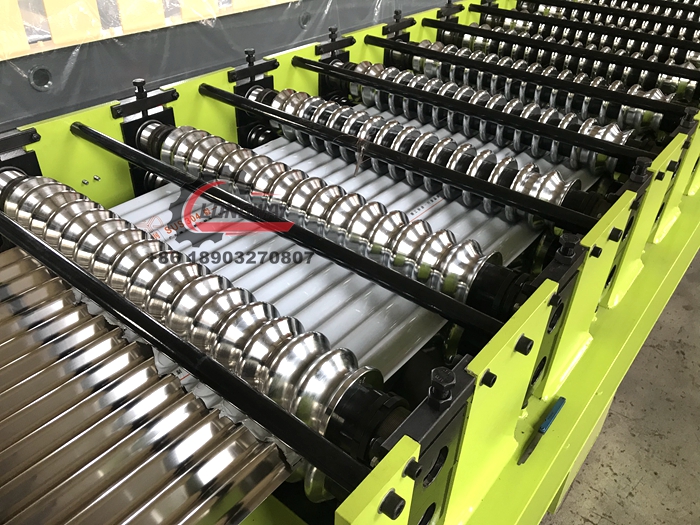trapezoidal sheet roll forming machine
Understanding the Trapezoidal Sheet Roll Forming Machine
In the ever-evolving landscape of manufacturing technology, the trapezoidal sheet roll forming machine has emerged as a pivotal tool for producing high-quality trapezoidal sheets. These sheets are widely utilized in the construction, roofing, and cladding industries, owing to their durability and aesthetic appeal. This article delves into the mechanics, benefits, and applications of trapezoidal sheet roll forming machines, shedding light on why they are indispensable in modern manufacturing.
What is a Trapezoidal Sheet Roll Forming Machine?
A trapezoidal sheet roll forming machine is a specialized piece of equipment designed to create trapezoidal-shaped metal sheets from coils. The process begins with a flat metal sheet, typically made of steel or aluminum. This flat sheet is fed into the machine, where a series of rollers progressively shapes it into the desired trapezoidal profile. The rollers are precisely designed and arranged to ensure consistent shaping and allow for rapid production rates.
The machine can be configured to produce different dimensions and thicknesses of trapezoidal sheets, making it a versatile tool for manufacturers. The output sheets can vary in width, length, and height of the trapezoidal sections, providing flexibility to meet specific customer requirements.
The Manufacturing Process
The roll forming process involves several key steps
1. Loading The metal coil is loaded onto the entry system of the roll forming machine. 2. Feeding The coil is unwound and guided into the roll forming station, where it is fed through a series of rollers.
3. Shaping As the sheet passes through the rollers, it is progressively shaped into the trapezoidal profile. The design of the rollers plays a critical role in achieving the desired dimensions and finish.
4. Cutting After the sheet has reached the desired length, it is cut using an automated cutting system. This allows for large volumes of sheets to be produced quickly.
trapezoidal sheet roll forming machine

5. Finishing The final step often includes quality checks and surface treatments, ensuring that the sheets meet industry standards.
Key Benefits of Trapezoidal Sheet Roll Forming Machines
1. Efficiency These machines are capable of producing large quantities of trapezoidal sheets with minimal waste. The continuous process allows for high-speed production, making it an efficient choice for mass manufacturing.
2. Customization Manufacturers can adjust the machine settings to produce sheets of various sizes and profiles, catering to different project requirements. This adaptability is crucial in a market that demands bespoke solutions.
3. Cost-Effectiveness While the initial investment in a trapezoidal sheet roll forming machine can be substantial, the long-term savings in labor and material waste can make it a smart financial choice for manufacturers.
4. Durability and Strength The trapezoidal sheets produced by these machines are not only lightweight but also exhibit excellent strength-to-weight ratios, making them ideal for use in structural applications.
Applications
Trapezoidal sheets created by roll forming machines are integral to various sectors. In construction, they are commonly used for roofing, wall cladding, and gutter systems due to their robustness and resistance to weather elements. The aesthetic versatility of trapezoidal sheets also makes them suitable for architectural projects, where design flexibility is essential.
In summary, the trapezoidal sheet roll forming machine is a crucial innovation in the manufacturing industry. Its ability to produce high-quality, customizable sheets efficiently positions it as a vital asset for manufacturers in the construction and architectural sectors. As industries continue to evolve, the role of advanced equipment like the trapezoidal sheet roll forming machine will undoubtedly grow, paving the way for more innovative building solutions.
-
Roof Panel Machines: Buying Guide, Types, and PricingNewsJul.04, 2025
-
Purlin Machines: Types, Features, and Pricing GuideNewsJul.04, 2025
-
Metal Embossing Machines: Types, Applications, and Buying GuideNewsJul.04, 2025
-
Gutter Machines: Features, Types, and Cost BreakdownNewsJul.04, 2025
-
Cut to Length Line: Overview, Equipment, and Buying GuideNewsJul.04, 2025
-
Auto Stacker: Features, Applications, and Cost BreakdownNewsJul.04, 2025
-
Top Drywall Profile Machine Models for SaleNewsJun.05, 2025








